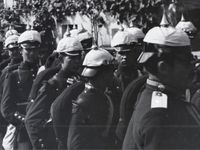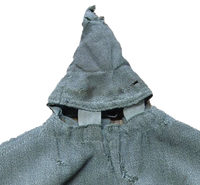About the helmet covers of the Pickelhauben
With the highest cabinet order of May 17, 1892, the reed-green helmet cover was generally introduced, which on the one hand replaced the white maneuver covers to distinguish the participating parties, but in contrast to these had other tasks.
Up to 1884, soldiers put green foliage on their headgear during maneuvers to distinguish between the warring parties. With AKO of May 8, 1884, the white maneuver covers just mentioned were introduced for this purpose. As seen in Figure 1, the covers didn't fit well and were only hooked laterally around the rosettes. The spike, the front visor with the metal trim, a part of the rear spine and the chinscales were not covered.
For this reason, even if they had been given a different color, they were only suitable for distinguishing the combat parties during maneuver exercises, since too many sunlight-reflecting metal parts remained uncovered, and the helmets thus provided good orientation for enemy riflemen. In order to avoid this disadvantage for combat, the metal fittings had to be circumstantially blackened with amber varnish since 3.7.1849, which was to be removed again after the war.
A way to simplify this process was therefore sought for a long time and the helmet cover from 1892 was the solution. It was lightweight and, unlike the white maneuver cover, covered the entire helmet. In addition, it was a cost-effective solution, according to Prussian taste, it was quickly ready for use and just as quickly removable. Last but not least, its reed-green color provided quite good camouflage in European nature, so the benefits outweighed the initial reservations about its clumsy appearance.
The M1892 cover was hooked onto the front and rear visors by means of nickel-silver hooks in accordance with the clothing regulations. Before 1896, the metal of the hooks was not yet specified in the clothing regulations, so for older covers they could be made of other metals. It should cover the whole helmet and fit tightly to it. The helmet covers of the enlisted men usually had 3 blackened nickel silver hooks in the front and 2 in the back (Figure 2).
Instead of the hooks, the officers‘ covers mostly had stiffened brims (Figure 3), which completely enclosed the visors of the spiked helmet and thus fitted much better. In addition, they often had elastic bands sewn into the sides or small steel springs in the seams to improve the fit even further.
1903 at the latest, elastic bands were also mandatory for enlisted men helmet covers, as can be seen from the clothing regulations for enlisted men from that year. This should avoid the sometimes overly loose fitting helmet covers (Figure 4).
Despite the quite detailed regulations, which expressly required hooks to attach the covers to the helmet, deviations were apparently tolerated. For example, enlisted men covers with the brims of the officers covers, or combinations of hooks and brims are known. The focus of the army command was probably exclusively on a completely covered helmet and a tight fit.
The cloth cone for the spike of the helmet was usually sewn to the cover with cloth strips so that the head ventilation could continue to function (Figure 5). With the introduction of the M95 Pickelhaube, a slot for the newly introduced ventilation slider was also added to the rear spine.
Up to 1897, all covers had no markings. It was not until the AKO of 28.1.1897 that markings were introduced, initially only for the infantry and reserve infantry regiments. These were to wear their regimental number in red Arabic numerals, on the front of the helmet covers (Figure 6). The reserve infantry regiments also wore a red "R" above the regimental number (similar to Figure 7). For the Peace Formation regiments, the signs were made of red cloth and were sewn to the helmet cover. To save costs and time, however, the numbers for the additional regiments of the wartime formations were to be painted on merely with waterproof paint (see clothing regulations for enlisted men of 1903, page 106, §44).
When the pickelhauben were gradually introduced for the Landwehr infantry regiments on 27.1.1899, they initially also wore helmet covers without marking. However, this changed already one year later, when on 8.2.1900 it was ordered that the Landwehr infantry regiments, which were already equipped with helmets according to the just mentioned AKO, should wear red regimental numbers made of cloth on their helmet covers, just like the line infantry. Analogous to the reserve infantry, they were to be marked with an "L" above the regimental number instead of the "R".
On 3.7.1900, the red regiment numbers were also adopted for the field artillery regiments.
All other branches of arms not previously mentioned continued to wear no marking on their helmet covers.
Somewhat irritating for me was first the following AKO of 26.3.1906, with which for the cavalry in the mobilization case the putting on of helmet covers without marking was ordered. Covers for hussars and ulans were already mentioned in the clothing regulations of 1896 and the book "Die deutsche Armee im 1. Weltkrieg" (Militaria-Verlag) shows the sample of a helmet cover for a metal pickelhaube from 1898. So there were helmet covers for cavalry units already before 1906.
In my opinion, the regulation can only be explained by the fact that until then cavalry units wore their covers only during maneuvers, to distinguish the parties. In 1906, the leadership realized that cavalry could no longer be used in combat as before, and that they could be targeted by enemy riflemen too. Therefore, the cavalry also had to avoid flashing helmet fittings in war.
As the last change before the 1st World War, a red maneuver band was introduced on 23.6.1909, to distinguish the units during the Kaiser maneuvers. This 6 cm wide cotton band, just like the helmet cover itself, was to be attached to it by means of hooks and eyes. However, reversible helmet covers with a red cloth strip sewn on one side are also known, so that the band could not get lost.
Shortly after the start of World War I, it became clear that the visibility of soldiers had to be further reduced. The field gray uniforms and the reed-colored helmet covers provided a fairly good camouflage, but the red numbers were almost as visible as the reflective metal parts on the uniforms. Due to the previously long period of peacetime, the army command apparently lost some of its focus, which is why it did not recognize this disadvantage in the maneuver exercises. However, they reacted very quickly and already on 15.8.1914 the red numbers on the helmet covers were ordered to be replaced by regimental numbers in camouflage green (Figure 7). This time, moreover, all branches of the armed forces (except the Guard Corps) were to wear the numbers.
Just another 4 days later, the importance of removing sunlight-reflecting objects and the red numbers on helmet covers was again explicitly stressed.
In this War, more troops and units were assembled than ever before and quite a few regiments or battalions were newly formed. All these units had to function together and the army command had to keep track of all the different units. Therefore, the German army experimented with more designations on the helmet covers during the first years of the war. No longer were only the green regimental numbers and numbers with an "R" or "L" above them used.
For the Landsturm battalions, for example, a green Landwehr cross was introduced on the helmet cover on 14.4.1915, and below it the battalion number in Arabic numerals (Figure 8).
As with other Landsturm regulations, however, this regulation was not uniformly implemented in the following period. So it came that the following markings, sewn and painted, were also documented:
- Landwehr Cross without battalion number.
- Completely missing marking for Landsturmtruppen.
- Landwehr crosses made of metal (which was actually absolutely inadmissible because of the reflections of the metal).
- Landwehr cross and below it the corps number in Roman numerals next to the battalion number in Arabic numerals.
- Landwehr Cross and below it the corps number in Roman numeral and again below it the battalion number in Arabic numeral.
- "L" in place of the Landwehr Cross (which normally stood for "Landwehr") and below it the corps number in Roman numerals next to the battalion number in Arabic numerals.
But as the AKO of 1.3.1916 shows, there were also authorized deviations from the rule. This regulation ordered newly formed batteries of foot artillery to wear the battery number on their helmet covers as long as they were not yet assigned to a foot artillery battalion unit. Furthermore, soldiers of ammunition columns of field artillery or foot artillery wore the column number in Roman numerals on their helmet covers (since ammunition supply was an Army Corps resource, the Roman numeral reflected the Army Corps). Photos of soldiers with atypical markings on their helmet covers also suggest other experimental designations.
On 21.9.1915 the field-gray peace uniform and the new helmet M15 were presented, why also the helmet cover was adapted again. Due to the removable top of the helmet, also the cloth cone was always a separate part. Furthermore, the M15 helmet covers had side slots for the chin straps (Figure 9).
Between October 1915 and March 1916, the fabrics of the helmet covers were also changed from reed green to field gray. On the one hand, this was certainly an adaptation to the new uniform, which was now entirely field gray, but on the other hand, the previous helmet covers had also worn out and faded too quickly in the field. For this reason, special attention was paid to the use of particularly lightfast dyes for the fabrics of the new covers, as the article in the „Färber-Zeitung“ of March 1916 shows.
At the end of 1916, however, it dawned on the Germans that the Entente also used the information on the helmet covers to identify the German units. As a result, on 27.10.1916 the order was also given to remove the green designations from them. Only the green crosses of the Landsturm were kept on the covers.
With the steel helmet then also the helmet covers became superfluous, since at these helmets no more decoration was led and they were painted immediately in camouflage color.

